MXA’S 2013 SUZUKI RM-Z450 MOTOCROSS TEST: IS IT A ONE TRICK PONY?

FIRST AND FOREMOST, IS THE 2013 SUZUKI RM-Z450 BETTER THAN THE 2012 RM-Z450?
A: Yes and no. First of all, it would be hard not to be, given that the 2012 Suzuki RM-Z450 was really the 2011 RM-Z450 with a red stripe on the seat cover. So, what we are really asking is…is the 2013 Suzuki RM-Z450 better than the 2011 RM-Z450. That shouldn’t be a hard target to beat, but Suzuki had some hits and some misses with the 2013 RM-Z.
Q: WHAT DID SUZUKI CHANGE ON THE 2013 RM-Z450?
A: The list of changes focused on engine performance, with the exception of the single-spring Showa SFF fork.
Piston. The 2013 RM-Z450 piston, piston pin and connecting rod are developed with the use of Finite Element Method (FEM) analysis. The new piston is 13 percent lighter. Some of the weight savings comes from a greater radius on the skirts that removes more material from the sides of the piston. The piston pin has a Diamond-Like Carbon (DLC) surface treatment for less friction and increased durability, and the pin is shorter to save weight.
Intake cam. The intake cam has 0.4mm more lift compared to last year.
Transmission. The transmission has been redesigned with a reshaped shift cam, stopper spring, shifter driveshaft and three-dog gears instead of last year’s four-dog cogs. The crankcase reed valve is made thinner for more efficient lubrication, and the oil strainer has a stronger magnet to catch more sludge in the engine oil.
Mapping. With more windings on the magneto, there is an 8 percent increase in electrical output. The RM-Z450 comes with three map couplers?stock, rich and lean?that can be changed in 30 seconds. Additionally, the ECU now has a self-diagnostic function that will flash Morse code-style flashes to tell you what is wrong with the engine. You need Suzuki’s optional fuel injection indicator light (P/N 36380-28H000) to access the codes (not to mention a quick eye to read the flashing light). There is an hour meter embedded in the ECU, but it also reports its time with flashing lights. Yes, you read that right. Thomas Alva Edison would be impressed, but most racers probably wouldn’t be.

Muffler. With redesigned internal muffler parts (a short perf core inserted inside the end-cap stinger and then inside the muffler’s normal perf core), the bottom-to-midrange power is improved. The muffler body uses conventional bolts instead of rivets to simplify the replacement of the glass wool packing. The 2013 RM-Z450 meets both the 115 dB two-meter-max and 94 dB SAE sound tests. In MXA‘s sound test, it pumped out 115.4 dB wide open and 93 dB at 4500 rpm.
Airbox. The air boot is reshaped and enlarged to aid airflow, while the back panel of the airbox is made of a carbon matrix material to reduce intake noise compared to the previous plastic airbox.
Fork. The 2013 RM-Z450 uses Showa Separate Function Forks (SFF) with separate spring and damping tasks. The right leg contains the spring, while the left leg incorporates the cartridge assembly to manage damping. The single-spring design results in reduced friction and a weight savings. The fork-tube diameter is increased from 47mm to 48mm, and the spring preload is adjustable. These forks have been used on the Kawasaki KX250F for the last two years.
Dust covers. The rear axle and top steering-head bearings have new seals to resist mud and dirt intrusion.

2013 Suzuki RM-Z450: For 2013 Suzuki tried to fix some?but not all?of their flaws while bringing the power down lower in the curve.
Q: WHAT WOULD MXA HAVE LIKED SUZUKI TO FIX FOR 2013?
A: We are happy that Suzuki tried to address its long-standing gearbox issues and tried to beef up the midrange power, but there were other issues that also needed attention. Maybe next year Suzuki will put some money into these five problem areas:
(1) Clutch. Suzuki’s clutch is marginal at best. Even when brand new, it is spongy and feels like it is always on the verge of slipping. We had to resort to stiffer clutch springs to keep the pack together.
(2) Overheating. The stock 1.1 kpf radiator cap isn’t sufficient to prevent boiling. We immediately switched to a 1.6 kpf cap (and suggest that every RM-Z450 owner do the same). Strangely, Suzuki’s engineers did modify the 2013 RM-Z250 cooling system with a new radiator hose layout, different fin pitch and a new bypass design, but didn’t bother with the 450.
(3) Rear-brake adjustment. Suzuki’s rear-pedal adjustment has a very narrow window. If you miss it, the rear brake will burn up. Caveat: There must be freeplay in the master cylinder’s slotted clevis.
(4) Weight. The RM-Z450 is the heaviest of the “Big Five” 450s?even heavier than the battery-equipped electric-start KTM 450SXF. It tipped our scales at 242 pounds.
(5) Front brake. When you have to squeeze real hard, you know things aren’t right
Q: HOW DOES THE 2013 SUZUKI RM-Z450 RUN ON THE DYNO?
A: The 2013 Suzuki RM-Z450 produced 54.10 horsepower on the dyno with 34.99 foot-pounds of torque. If you are into playing the numbers game, the 2012 RM-Z450 pumped out 54.08 horsepower and 35.11 foot-pounds of torque. Based purely on numbers, there is not much difference between the two machines, but peak dyno numbers don’t tell the whole story. Additionally, at 54.10 horsepower, the Suzuki is no match for the 56.95-horsepower KTM 450SXF or the 55.05-horsepower Kawasaki KX450F.

Plug in: the Suzuki comes with three plug-in maps. Most MXA test riders selected the white one.
Q: HOW DOES THE 2013 SUZUKI RM-Z450 ENGINE RUN?
A: There are four major engine components that interact to determine how the 2013 RM-Z450 runs. They are the lighter piston, higher lift cam, increased airflow intake boot and the restrictive “perf core inside the perf core” muffler. It would be an understatement to say that these components are often working at cross purposes. For example, the 13 percent lighter piston should produce a snappier and more responsive low-to-mid hit. And when paired with the higher lift cam (0.4mm more lift) and improved airflow, the result should be an aggressive burst of power right off idle. However, the end product of the piston, cam and air boot is more of a torquey pull from low to mid than an aggressive burst. Why did we get a metered gain of low-to-mid power instead of a quick turnover the numbers predicted? Two reasons:
(1) Although the intake valves are being allowed to open farther, they are most likely being opened more gradually over a longer period (with a casual cam lobe). More lift over a short duration would have resulted in a blast of power, but when you have a gradual arc to the cam lobes, you get a tamping down of the power.
(2) The real problem is the restrictive muffler. Squeezed-down muffler cores soften low-end power?and the 2013 Suzuki RM-Z450 muffler is definitely pinched off by the doubled-up perf cores in the last 4 inches of the muffler length.
But, the marriage of these four components is not as bad as it might seem. The piston, cam and air boot produce more horsepower off the bottom, while the gradual cam lobe makes that power ooze out of the RM-Z450 engine with a nice, chunky and strong low-to-mid transition. It’s not quick-revving, but well placed and usable instead. Of course, there is a corresponding loss of top-end power that is the trade-off for more low-to-mid power. After 9200 rpm, the 2013 can’t touch the horsepower of the 2012 RM-Z450 all the way to the 11,000 rpm rev limiter.
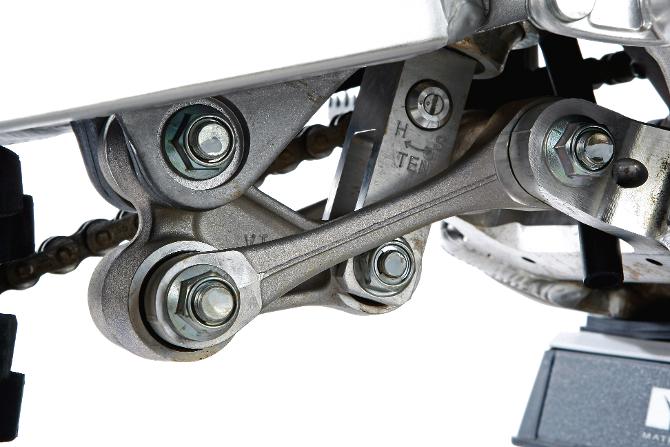
Rising up: Suzuki’s suspension setup is all new for 2013. Not only does it have new forks, but also a new rising rate shock linkage.
Q: WHERE DOES THE 2013 RM-Z450 ENGINE SHINE?
A: In a direct comparison to the 2013 KX450F, 450SXF, CRF450 and YZ450F, the Suzuki has decent roll-on power (as measured at 6000 rpm) and competitive midrange power (as measured at 8000 rpm). But, by 10,000 rpm the Suzuki is fourth out of five in horsepower. After 8400 rpm, it starts losing ground to the YZ-F, SXF and KX-F. Depending on where you like your power this could be no big deal. Why? Because the 2013 RM-Z450 is defined by its thrust off idle. Its tractable feel and easy-to-use powerband are its best traits. It doesn’t make the peak horsepower of the KTM, KX450F or YZ450F, but it does soundly trump the CRF450.
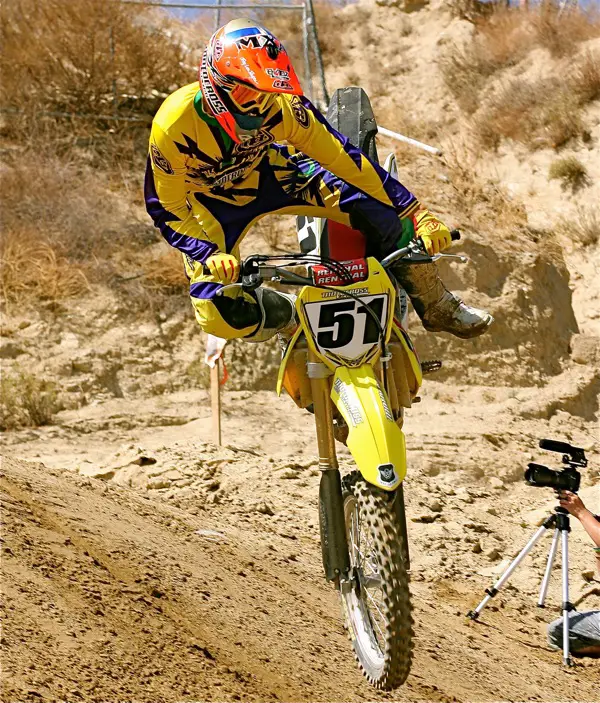
Although the heaviest 450 of 2013, it has a nice agile feel in motion?with the exception of the motion of putting it up on a bike stand.
Q: IS IT FAST?
A: It is, if you use the power properly, but in a flat-out wax race, it is more manageable than monstrous. It isn’t in the same power league as the KTM 450SXF or Kawasaki KX450…largely because the RM-Z powerband lacks breadth. This is a low-to-mid engine…and not much above that. Additionally, if you measured the number of rpm where the top 450cc motocross bikes stayed above 50 horsepower, you would find that the KTM 450SXF cracks 50 horses at 7400 rpm and stays over 50 horses until 11,300. That is a 3900 rpm range above 50 horses. For comparison, the RM-Z450 only gets above 50 horsepower for 2300 rpm (from 7600 to 9900 rpm). To make the most of the RM-Z450 powerband you have to work within these limits.
Q: IS IT BETTER THAN LAST YEAR’S ENGINE?
A: Yes, and no. Yes, for a finesse rider, and no for a hard charger.
Q: CAN THE RM-Z450 ENGINE BE MADE BETTER WITH SIMPLE MODS?
A: Yes. MXA‘s three-prong attack was to swap out the stock map coupler for the white one, gear it down by one tooth with a 51-tooth rear sprocket and substitute an aftermarket exhaust system for the stocker. This triple combination makes the RM-Z450 leaner, more aggressive and able to breathe.
Q: HOW DOES THE 2013 RM-Z450 HANDLE?
A: The RM-Z450 feels like the front end is attached to a roller-coaster track. The yellow bike can dive inside of every bike on the track?unless that bike is another Suzuki.
How did Suzuki get their bike to turn so well? We don’t really know. You would expect to find that Suzuki’s frame geometry would be as much as 2 degrees steeper and armed with less trail than the red, green, blue and orange brands, but just the opposite is true. It doesn’t have the steep head angle normally associated with sharp cornering and its trail is actually longer than the other brands. None of these numbers would recommend it as the sharpest-turning bike made, but motocross bikes don’t live or die by a single dimension. The Suzuki RM-Z450’s geometry is a mystery?even to those familiar with the art of geometry.
The proof isn’t in a single frame dimension, but in the interplay of every number, from head-angle degrees, to millimeters of trail, to inches of wheelbase, to percentages of weight bias. Somewhere in that magic mix of numbers, Suzuki has combined the turning ingredients in with the correct amounts. Don’t let the math confuse you. Just accept that the Suzuki RM-Z450 is the best-turning motocross bike on the track. On the other hand, it is very jittery at speed and alarmingly skittish in the rough.
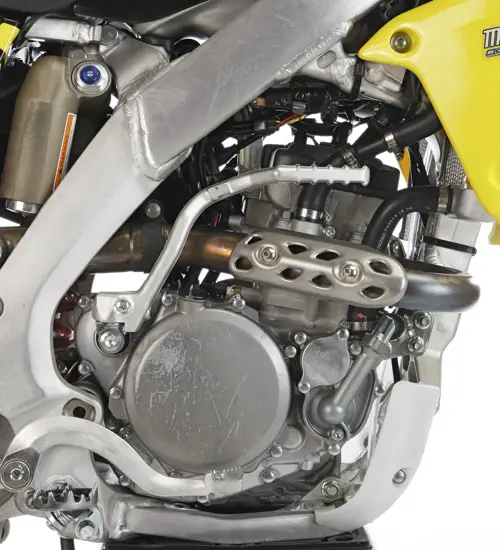
Go: Last year the power was broad, but lacked personality. This year it is torquier and quite unique.
Q: HOW IS THE SUSPENSION ON THE 2013 RM-Z450?
A: We didn’t like the forks in their stock settings (and we don’t know anyone who would). They had a jackhammer feel that worked great on a Supercross track, which is where we first tested the bike, but they were jarring on an outdoor track. The quick fix was to back out the compression damping, fiddle with the spring preload and try to find the perfect fork height to load the front end enough to activate the front forks?but not so much as to corkscrew the front tire into the ground.
Fork height is critical on the RM-Z450 because of its quick cornering. If you let the forks drop too much or have the fork legs too high in the triple clamps, the bike will oversteer. In the end every MXA test riders felt that the forks were way too harsh in the midstroke, and took out 20cc of fork oil from the right leg only. Then, we took out 20 more. The SFF?forks have issues on the RM-Z450. In a side note, the RM-Z250 forks work much better.
The rear shock was a little dead feeling, a feeling not helped by the new shock linkage?but perhaps that is the best sensation for a bike with such a hyper-kinetic chassis. We set the sag at 100mm and used the high-speed compression adjuster to set chassis height in motion. We turned it out to lower the rear and turned it in to raise the rear. This is a pressurized ride-height control, and it is important to get the balance of the RM-Z450 correct at speed.
Q: WHAT DID WE HATE?
A: The hate list:
(1) Clutch. There are bikes with bulletproof clutches and bikes with suspect clutches. Which clutch does the RM-Z450 have? It should be in a police lineup.
(2) Weight. At 242 pounds, the RM-Z450 is about 10 pounds heavier than it should be?but the same can be said for four out of five 450s.
(3) Overheating. This is the worst cooling system on any motocross bike. Word of warning! Don’t start the bike on the starting line too early?unless you want a swimming pool under your bike.
(4) Throttle grip. If you want to install an aftermarket grip on the RM-Z450 throttle tube, lots of luck. The stock grip is vulcanized onto the throttle tube.
(5) Rear brake pedal. It is a very touchy when you try to adjust the pedal downwards?not so bad when raising the pedal upwards.
(6) Shifting. When the tranny as brand–new the shifts seem crisp and precise, but after 20 hours the old missed-shift syndrome returned. Some riders, those with heavy left feet never had a problem, but the finesse shifters suffered constantly.
(7) Front brake. Might we suggest that the engineers at Honda, Yamaha, Kawasaki and Suzuki buy a KTM to feel what motocross brakes should feel like. The Suzuki front brake is weak.
(8) Forks. These are the worst forks of 2013.
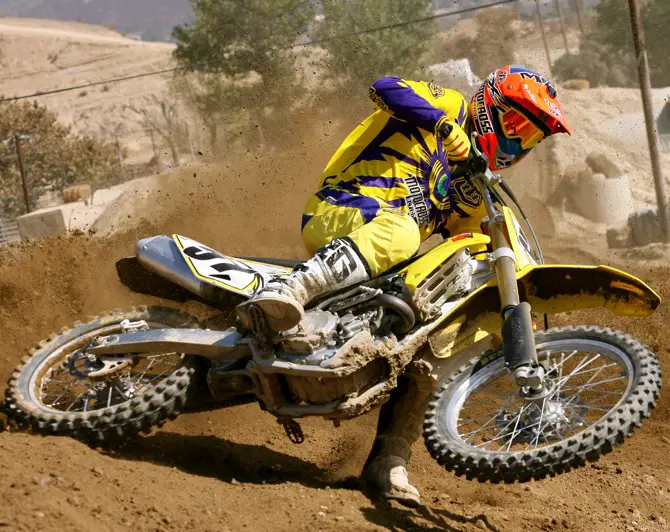
in a nutshell, the 2013 RM-Z450’s big pluses are its ability to turn like a cat chasing its tail and its well positioned low-to-mid powerband. The big negatives are weak brakes, spongy clutch, inefficient cooling, atrocious forks and 242 pounds of heft.
Q: WHAT DID WE LIKE?
A: The like list:
(1) Handling. It is razor-sharp at low speeds and St. Christopher-medal loose at high speeds. You don’t see very many Suzukis at a desert race.
(2) Powerband. We like the increase in low-end thrust, the torquier feel and the ability of the engine to thump down low.
(3) Tires. Bridgestone’s 403/404 tire combo is an MXA favorite.
Q: WHAT DO WE REALLY THINK?
A: If you are thinking of buying a 2013 Suzuki RM-Z450 for its horsepower, suspension, clutch or ergos, you are barking up the wrong tree. You buy a Suzuki for its turning prowess?and live with the rest of the package.
MXA’S 2013 SUZUKI RM-Z450 SETUP SPECS
This is how we set up our 2013 Suzuki RM-Z450 for racing. We offer it as a guide to help you get your own bike dialed in.
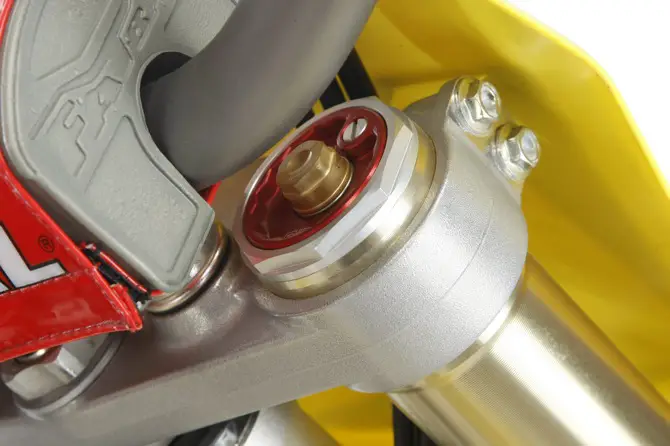
SHOWA SFF FORK SETTINGS
Called Showa Separate Function front Forks (SFF), they really should be called Single Spring Forks (SSF), because their most significant feature is that they only have one fork spring (in the right fork leg). These forks have been on the Kawasaki KX250F for several years. You might wonder why Suzuki didn’t go with air forks, like the 2013 KX450F and CRF450. The most likely answer is that Suzuki is a loyal Showa customer, and the Showa air fork is not ready for production use yet?so SFF is the newest thing in their OEM arsenal. The MXA wrecking crew likes the various options that the Showa SFF provides?but we didn’t like these forks in stock trim.
For hardcore racing, we recommend this fork setup for the 2013 Suzuki RM-Z450 (stock specs are in parentheses):
Spring rate: 1 kg/mm
Oil height: 310cc in left leg, 310cc in right leg (350cc stock in right leg)
Compression: 15 clicks out (9 clicks out)
Rebound: 12 clicks out
Preload adjuster: 6 clicks in
Fork-leg height: 5mm up
Notes: The SFF forks don’t work very well off the showroom floor. They come with 350cc of oil in the right leg, while the identical fork on a Kawasaki has 100cc less. Lower oil height helps, but this bike needs less compression damping.
SHOWA SHOCK SETTINGS
For hardcore racing, these are MXA‘s recommended 2013 Suzuki RM-Z450 shock settings:
Spring rate: 5.7 kg/mm
Race sag: 100mm
Hi-compression: 2 turns out
Lo-compression: 12 clicks out
Rebound: 12 clicks out
Notes: The key to success with the shock is to get the front fork to work. If the fork is wrong, all the load will be handled by the shock. The main goal is to find a balance between the front and rear. The shock starts out in the ballpark, so many shock issues are actually fork issues.





Comments are closed.